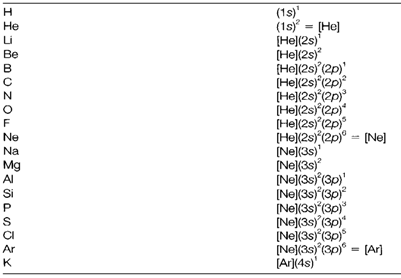Building up
As per the aufbau principle, the ground-state electron configuration of an atom can be come into existence by putting electrons within the orbitals, starting with that of lowest energy and moving progressively towards the higher energy. It is essential to take into account both the exclusion principle and the modification of orbital energies by screening and penetration effects. So following He (1s)2, the electron configuration of Li is (1s)2(2s)1, like the 2s orbital is of lower energy than 2p. The 2p orbitals are first occupied in B (see Table 1). Total of six electrons can be accommodated Within these three orbitals, thus up to Ne.
Table 1. Electron configuration of ground-state atoms up to K (Z=19)

Following completion of n=2 orbitals, 3s and then 3p shells are filled. The elements' electron configurations Na-Ar thus parallel those of Li-Ne with only a change in the principal quantum number n. An abbreviated form of the configurations is frequently employed, writing [He] for the filled configuration (1s)2 and [Ne] for [He](2s)2(2p)6. The inner shell orbitals that are denoted by these square brackets are too tightly bound to be involved in chemical interactions: it is the outer electrons or valence, which determine chemical properties. The periodic table's group structure of depends on the fact that identical outer electron configurations are reflected in identical chemical behaviour.
It might be supposed that 3d orbitals would fill after 3p, but actually this does not happen, since the extra penetration of s compared with d orbitals considerably lowers the energy of 4s. This fills first, thus that following Ar the first two elements of the fourth period K ([Ar](4s)1) and Ca ([Ar](4s)2) have configurations parallel to Na and Mg, correspondingly. The 3d orbitals then fill, giving 10 elements Sc-Zn, followed by 4p. The fifth period follows identically, 5s, 4d then 5p. In the sixth period another change takes place, with filling of the 4f shell after 6s and before 5d. The seventh not complete period begins with 7s followed by 5f and would be supposed to continue in identical way, but these elements become increasingly radioactive and hard to make or study. The order of filling of shells is suitably summarized in diagram 1. It is significant to notice that it reflects the order of
energies at the suitable point and that this order changes somewhat as more electrons are added. So following completion of the 3d shell increasing atomic number stabilizes these orbitals rapidly so that they are no longer chemically active; in an element like Ga ([Ar](3d)10(4s)2(4p)1) the valence orbitals are efficiently only the 4s and 4p, so that its chemistry is identical to that of Al ([Ne](3s)2(3p)1). The same is right following completion of each d and f shell.